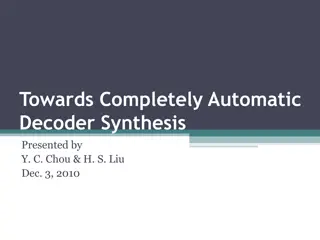Automatic Model Inconsistency Fixing and Beanbag Language
Comprehensive overview of supporting automatic model inconsistency fixing, motivations behind modeling complex relations in software systems, using OCL for relation description, addressing inconsistency challenges, existing approaches for fixing, and proposing a solution through the Beanbag language. Beanbag offers a unique approach to specifying fixing behaviors from a consistency relation perspective, enhancing automated model fixing procedures.
Download Presentation

Please find below an Image/Link to download the presentation.
The content on the website is provided AS IS for your information and personal use only. It may not be sold, licensed, or shared on other websites without obtaining consent from the author.If you encounter any issues during the download, it is possible that the publisher has removed the file from their server.
You are allowed to download the files provided on this website for personal or commercial use, subject to the condition that they are used lawfully. All files are the property of their respective owners.
The content on the website is provided AS IS for your information and personal use only. It may not be sold, licensed, or shared on other websites without obtaining consent from the author.
E N D
Presentation Transcript
Supporting Automatic Model Inconsistency Fixing Yingfei Xiong University of Tokyo, Japan Zhenjiang Hu National Institute of Informatics, Japan Haiyan Zhao Peking University, China Hui Song Peking University, China Masato Takeichi University of Tokyo, Japan Hong Mei Peking University, China
Motivation Model software system often involves models with complex relations. Equal 2
Relation Description in OCL Equal C1: context Message inv let rec = self.receiver in let ops = rec.base.operations in ops->exists(oper | oper.name = self.name) 3
Inconsistency Inconsistency will be caused when some part is updated by users Not equal! choose 4
Inconsistency Fixing We need to propagate the updates to other part of the model to fix the inconsistency. choose choose 5
Existing Approaches Manual Fixing Procedures By common programming languages [Grundy94] By logic expressions [Finkelstein94, Straeten03] Fully automated fixing, but requires considerable development cost Generating Fixing Actions from Consistency Relations White box analysis [Egyed08] Black box analysis [Nentwich03] Fully automated development, but requires user intervention in fixing
Can we automatically derive fixing procedures from consistency relations? 7
Fixing Behavior Ambiguity C1: context Message inv let rec = self.receiver in let ops = rec.base.operations in ops->exists(oper | oper.name = self.name) A consistency relation may correspond to multiple fixing behaviors Need developers to tell the system which one to use choose() choose choose 8
Our Solution : Beanbag Beanbag A language for specifying fixing behavior from consistency relation perspective similar to OCL syntactically has enriched constructs to describe a unique fixing behavior Every Beanbag Program has two types of semantics Checking semantics for checking whether the relation is satisfied Fixing semantics for fixing inconsistency by update propagation 9
Working Process of Beanbag Updates ------------ ------------ ------------ ------------ Compile Fixing Procedure Application Data Beanbag Program Updates 10
Example 1 : A Simple Program 2 2 2 a=1 b=1 c=1 def main(a, b, c) := a = b and b = c input values: {a=1, b=1, c=1} input updates: {a->2} output updates: {a->2, b->2, c->2}
Example 2: Customizing Fixing Behavior obj1 obj2 name=Book persistent=true persistent=false name=Book name=Book def main(obj1, obj2) := obj1."persistent" = true and obj2."name" = obj1."name" or obj1."persistent" = false and obj2 = null or obj1 = null and obj2 = null input values: {obj1={name=Book, persistent=true}, obj2={name=Book}} input updates: {obj2->null} output updates: {obj1->{persistent->false}, obj2->null}
Example 2: Customizing Fixing Behavior obj1 obj2 name=Book persistent=true name=Book def main(obj1, obj2) := obj1."persistent" = true and obj2."name" = obj1."name" or obj1 = null and obj2 = null or obj1."persistent" = false and obj2 = null input values: {obj1={name=Book, persistent=true}, obj2={name=Book}} input updates: {obj2->null} output updates: {obj1->null, obj2->null}
Example 3: the Running Example context Message inv let rec = self.receiver in let ops = rec.base.operations in ops->exists(oper | oper.name = self.name) OCL def C1(msg, model) = let rec = model.(msg."receiver") in let opRefs = model.(rec."base")."operations" in opRefs->exists(opRef | model.opRef."name"=msg."name") Beanbag 14
Overview: Constructs in Beanbag expr ::= variable | constant | expr.expr | not expr | expr=expr | expr and expr | expr or expr | expr->forall(v|expr) | expr->exists(v|expr) | expr->exists!(v|expr) 15
Overview: Enriched Constructs for Specifying Synchronization Behavior OCL Constructs expr1=expr2 Enriched Constructs expr1=expr2 expr2=expr1 expr1 and expr2 expr2 and expr1 expr1 or expr2 expr2 or expr1 expr->exists(v | expr) expr->exists!(v | expr) expr1 and expr2 expr1 or expr2 expr->exists(v | expr) 16
The Fixing Semantics Basic relations (like a=b) Primitive fixing procedures gluing their small fixing procedures into a bigger one Connectives (like and, or, forall) Consider an example: Relation: a=b and b=c and a=b b=c 17
Primitive Fixing Procedures: a=b a=b 3 3 3 3 a=2 a=2 a=2 a=2 3 3 3 4 b=2 b=2 b=2 b=2 report conflict 18
Combinator and a=b b=c a=3 b=3 c=3 1 1 1 19
Correctness Properties The fixing semantics of Beanbag is well- defined in the sense that it satisfies the following three properties Consistency Preservation Stability 20
Consistency After fixing, the data always satisfy the consistency relation choose Equal choose 21
Preservation A fixing procedure does not overwrite user updates select choose 22
Stability If there is no update, the fixing procedure produces no update. 23
Evaluating the Expressiveness Steps Collected 84 consistency relations from MOF standard, UML standard, and industry [Egyed07] Identified requirements for 24 fixing procedures Implementing these programs in Beanbag Result Implemented 17 programs, 71% of all programs The rest 7 programs can be implemented with small extensions to Beanbag 24
Implementation Beanbag has been implemented and published on the web Beanbag URL: http://www.ipl.t.u- tokyo.ac.jp/~xiong/beanba g.html An old version has been used by several other research groups [RKK+09] A graphic UML synchronization tool that is developed by University of Malaga using Beanbag 25
Conclusion Inconsistency fixing can be approached by a language attaching fixing actions to primitive relations gluing primitive relations by combinators The fixing behavior of the language is predictable as it satisfies the three properties The language is expressive as it can express many useful fixing behaviors in practice 26
Thank you for your attention! Beanbag URL: http://www.ipl.t.u-tokyo.ac.jp/~xiong/beanbag.html
What Relations are Suitable for Automatic Inconsistency Fixing Fixing actions need to be taken obj. name = SpecialName Fixing is sensible without human intervention No Circle Inheritance
What Small Extensions are Needed One program requires a new constraint without fixing action A function count the number of entries in dictionary Other six programs require the ability to access key in forall All extensions conform to the basic idea of Beanbag attaching fixing actions to primitive expressions, and composing them using high-level constructs.























